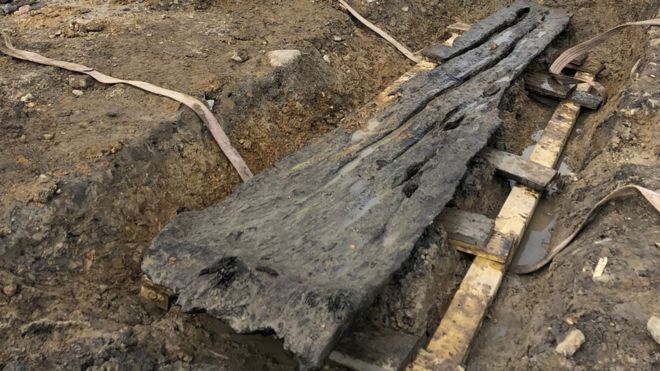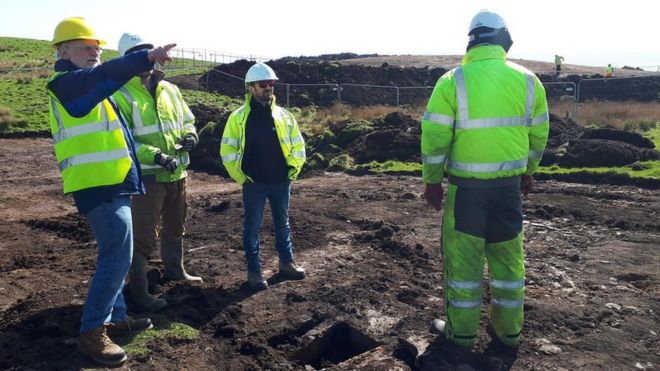The Prehistoric Archaeology Blog is concerned with news reports featuring Prehistoric period archaeology. If you wish to see news reports for general European archaeology, please go to The Archaeology of Europe Weblog.
Monday, May 27, 2019
LATE BRONZE AGE SETTLEMENT DISCOVERED IN NORTHWEST BULGARIA IN TURKISH STREAM GAS PIPELINE RESCUE DIGS
A settlement originally dating back to the Late Bronze Age, which was also subsequently inhabited in the Thracian and Roman Antiquity, and the Middle Age, has been discovered by archaeologists near Rasovo in Northwest Bulgaria during rescue excavation on the projected route of the Turkish Stream natural gas transit pipeline.
A total of three archaeological sites have been found along the route of the proposed extension of the Turkish Stream gas pipeline (dubbed Turkish Stream – Northwest) that would potentially be transporting natural gas from Russian via the Black Sea, Turkey, and Bulgaria into Central Europe.
One of the three newly discovered sites is the settlement from the very end of the Bronze Age dating back to ca. 1,200 BC near today’s town of Rasovo, Medkovets Municipality, Montana District, in Northwest Bulgaria.
Because of the fact it was also inhabited during later historical periods, however, the archaeologists have described it as a “multilayer settlement".
Read the rest of this article...
Roadworks uncover Bronze Age urn burial site in Saxony-Anhalt, Germany
Credit: ct-press
More than 100 cremation burials dating to around 800 BC have been found here, reports chief archaeologist Susanne Friederich, head of the department for the preservation of archaeological monuments at the State Office for Archaeology and Monument Conservation.
"The place obviously served as a 'cemetery' for several villages, whose remains were also found nearby", she said
"The deceased were burned on pyres. Their relatives placed their ashes and bone remains in urns, together with anything which had not been destroyed by fire, such as bronze clasps or jewellery made of metal," excavation leader Anette Schubert explains.
NOUVELLE FOUILLE DE LA TOMBE DE LA « DAME DE VIX »
Le site de Vix en Côte-d’Or est avant tout célèbre pour la tombe de « la Dame de Vix », dont la fouille, menée en 1953, a révélé un mobilier d’une incroyable richesse. Hormis la sépulture, le vaste monument funéraire qui l’abritait n’a jamais été réellement fouillé. D’août à novembre 2019, il fera l’objet, d’une importante fouille sous la direction de l’Inrap (Bastien Dubuis), en partenariat avec le Laboratoire ARTEHIS (CNRS/Université de Bourgogne) et avec le soutien de la DRAC Bourgogne-Franche-Comté et de la Communauté de Communes du Pays Châtillonnais. Les nouvelles approches et méthodes de l’archéologie devraient permettre une contextualisation et une compréhension plus fine de cette tombe emblématique du phénomène princier celtique.
Read the rest of this article...
Sunday, May 26, 2019
'Phenomenal' 2,300-year-old bark shield found in Leicestershire
The shield is made from green bark that has been stiffened with internal wooden laths.
An “astonishing and unparalleled” 2,300-year-old shield made of tree bark has been discovered in Leicestershire, the only example of its kind ever found in Europe.
Archaeologists say the discovery of the shield, made between 395 and 250BC, has completely overturned assumptions about the weapons used in the iron age, sparking breathless reactions among experts of the period.
“This is an absolutely phenomenal object, one of the most marvellous, internationally important finds that I have encountered in my career,” said Julia Farley, curator of British and European iron age collections at the British Museum.
“So often it is gold which grabs the headlines, but this bark shield is much rarer.”
Read the rest of this article...
Wednesday, May 22, 2019
New data platform illuminates history of humans' environmental impact
Animal bones on display.
Credit: © DedMityay / Adobe Stock
The human environmental footprint is not only deep, but old.
Ancient traces of this footprint can be found in animal bones, shells, scales and antlers at archaeological sites. Together, these specimens tell the millennia-long story of how humans have hunted, domesticated and transported animals, altered landscapes and responded to environmental changes such as shifting temperatures and sea levels.
Now, that story is available digitally through a new open-access data platform known as ZooArchNet, which links records of animals across biological and archaeological databases.
Making these specimen records accessible digitally helps provide a long-term perspective on current biodiversity crises, such as animal extinction and habitat loss, and could lead to more informed conservation policies, said Michelle LeFebvre, postdoctoral associate at the Florida Museum of Natural History and lead author of a study introducing ZooArchNet.
Read the rest of this article...
Sunday, May 19, 2019
Analysis of the Palaeolithic diet shows no social divisions in food consumption
Credit: University of Granada
The study of the human diet in Palaeolithic times is currently among the research areas generating the greatest advances in knowledge. Analysis of the Palaeolithic diet is conducted mainly on the basis of stable isotopes of carbon and nitrogen, which are present in the collagen of human bones. These isotopes indicate the types of food consumed by the individual in the years leading up to their death.
Researchers from the University of Granada (UGR) have analyzed the diets of past peoples from samples in the anthropological collections of the Megalithic necropolises of Panoria (Darro, Granada) and El Barranquete (Nijar, Almeria). They find that although Megalithic communities did vary their eating habits over time, there were no relevant social differences, either in the type of food or in the proportion of proteins consumed.
Read the rest of this article...
Friday, May 17, 2019
Chewing gums reveal the oldest Scandinavian human DNA
Masticate being examined
[Credit: Natalija Kashuba/Stockholm University]
[Credit: Natalija Kashuba/Stockholm University]
The first humans who settled in Scandinavia more than 10,000 years ago left their DNA behind in ancient chewing gums, which are masticated lumps made from birch bark pitch. This is shown in a new study conducted at Stockholm University and published in Communications Biology.
Ancient chewing gums are as of now an alternative source for human DNA and possibly a good proxy for human bones in archaeogenetic studies. The investigated pieces come from Huseby-Klev, an early Mesolithic hunter-fisher site on the Swedish west coast. The sites excavation was done in the early 1990's, but at this time it was not possible to analyse ancient human DNA at all, let alone from non-human tissue. The masticates were made out of birch bark tar and used as glue in tool production and other types of technology during the Stone Age.
Read the rest of this article...
Fossil teeth push the human-Neandertal split back to about 1 million years ago
CROWNING ROOTS An analysis of hominid tooth evolution, including specimens from Spanish Neandertals (top row), pushes back the age of a common Neandertal-human ancestor to more than 800,000 years ago. The bottom row shows Homo sapiens teeth.
People and Neandertals separated from a common ancestor more than 800,000 years ago — much earlier than many researchers had thought.
That conclusion, published online May 15 in Science Advances, stems from an analysis of early fossilized Neandertal teeth found at a Spanish site called Sima de los Huesos. During hominid evolution, tooth crowns changed in size and shape at a steady rate, says Aida Gómez-Robles, a paleoanthropologist at University College London. The Neandertal teeth, which date to around 430,000 years ago, could have evolved their distinctive shapes at a pace typical of other hominids only if Neandertals originated between 800,000 and 1.2 million years ago, she finds.
Gómez-Robles’ study indicates that, if a common ancestor of present-day humans and Neandertals existed after around 1 million years ago, “there wasn’t enough time for Neandertal teeth to change at the rate [teeth] do in other parts of the human family tree” in order to end up looking like the Spanish finds, says palaeoanthropologist Bernard Wood of George Washington University in Washington, D.C.
Read the rest of this article...
Bronze Age Caernarfon bypass find 'could be canoe'
If proven to be a canoe the timber would be a "rare find", according to experts
WELSH GOVERNMENT
Work on a bypass in Gwynedd has revealed the site of a Bronze Age mound which could contain an ancient canoe.
Archaeological excavation on the site of the Caernarfon-Bontnewydd bypass uncovered three troughs underneath a burnt mound dating back about 3,500 years.
Experts think one of the troughs may have been originally used as a dug-out canoe hollowed from an oak tree.
It would be the first prehistoric canoe ever found in north Wales if proven.
The timber has now been lifted from its discovery site and is being examined in more detail.
Bronze age burial uncovered at Orkney sub station site
The cist archaeologists have uncovered lies on top of a glacial mound
ORCA ARCHAEOLOGY
The stone lined box capped with a large flat stone was unearthed at Finstown, ahead of construction work by SSEN Transmission.
The pit - known as a cist - appears to be empty, though it would once have contained bones or cremated remains.
It's thought the burial dates back around 3,500 years.
The team from ORCA Archaeology based at Orkney College are exploring and recording the features and history of the site on behalf of the power firm.
Read the rest of this article...









